Lewin Benjamin (ed.) Genes IX
Подождите немного. Документ загружается.


I€E
&euun5
'sauab
lsoq;o
6urruelrs asner ^eu
VNUsp
.
'VNUsp
1ror.ls
p
jo pue.lls
raqlra ol
fireluau
-elduor
SVNUr.u
Jo
uoLleperbap
sta66ul aluotaJtalur
!lrl!
r
6ur:ua1r5 aueg o]
paleleu
sI eruaralalul
VNU
'SVNUur
1a6re1
ur saruanbes &eluaualduor
qluvr
6uured aseq '\q uorssardxa
auab e1elnba.r s!fl!oDr[
e
svNUollrur
pallPl
salnlaloru
vNU
(aseq
ZZ-)
loqs
fueu
ioj apol sauouab
1ue1d
pue
leuru!
r
salo&plnl
[ue61
ur slolelnbau arv sVNUol]rW
'1eaa1
leuoqdulsuP.llsod
aql
lP
ool
O[<
1o
uolssa.rdxa sasselder ro sele^rl]e
ylgs
5[xg
aq1
o
'ssaua^qla#a
rlaql saseo.llu
r
qrrqm
'b1g
uralord aq1 Aq
punoq
are SVNUs ar.lf
Jo le.raAag
r
'sVNUs
pallpl
aip SVNU rolelnbar1pga]lpfl
o
svNU roleln6au urPluol Puapeg
'asPallnuopue
ue rol
1abre1
p
alean ro
'uorldursuell
Jo
uoqeurulel
asnpl
'uorlelsuerl
Jo
uoqeqrur
1ro1q
r{eu xaldnp aq1
r
'y;1X
1a6re1
e
qlwr
uorbar xaldnp
e 6uLturol r\q suorlrun;
yp6
tolelnEar
y
r
uor.lqsuerl alplnbau
uel salnlalop
VNU
lleus
's11ar
rtlortelne olur
pelnporlur
uaqM s1a6.lpl rraql
Jo
uolssaldxa
1ro1q
saua6 asuoSrluI
o
uolsseloxl
aua9 ale^qleul
o]
pasn
ag upl
vNu
asuasquv
'sanu!1u01
uorldulsuprl
1eq1
os
'uLdrreq
eql
Jo
uotlPturo' sluanald
ainllnrls
fuepuoras a^qeurolle
up
pup
suopot ueqdoldfit1
aql
le
sllels aurosoqu aq1
'ueqdoldr\tl
Jo
atuasqe a!| ul
o
'uorleururel
sasnPr
leql
ulorrPq
aql uroJ 01 alqP st
lolenuoilP aql
puP
'palplsuprl
sr leppal aql
'upqdoldful
1o
aruasatd a!} ul
o
'palplsuPjl
sr aue.4 DurpPor srql
laqleqM
u0 spuaoap lolenueilP
aql
lP
VNU
J0
alnllnlls a[]f
r
'ueqdold&1
lo1
suopol
oMl sapnllur
leql
aueiJ 6uLpear uedo
uopol-uoailnoJ
P sPq uolado d.r] eq1
1o
uotbal
tepeel aq1
o
uorlPlsuPll
Aq
pa11or1uo3
e8 ueJ uor.lPnuanv
'u0rl0ulsuPrl
ut asPollu!
x0[
e
ut sllnsel
pue
uorleururel
sessarddns ueqdold&1
Jo
aluasQp oql
o
'lalsnlr
d/l aq1;o aua6
leg
aql
pue
raloutord aq1
uaeMleq
palerol
sr
(roleurural
rrsuulut) rolpnua||p u!
r
uoqenuailv Aq
pallorluol
sI uolado uDr.ldoldful
ttos Dtwuaqzsl eql
'arlVNUl
pabreqrun Aq
palLqrqur (flparrpur)
sl
dVUI
Jo
flLrrlry
o
'sauob
d4
Jo
uoqdulsuell
luanatd
o1
ueqdoldr{r1
[q
pale,rqre
sl
dVUI
pa11er
uLalotd
]o]putureJ
!
o
a,lVNUl
Aq
Pue
uPqdoldArl /tq
pallorluol
{
seueg dt1 sllpqns snnDoS
Jo
uoqeururel
'utdrreq
aql azrtrqelsap lo
ezrtrqels laqlro
leql
sulal
-ord
anlo,rur uorlenua11p
roJ srusrueqlau
]lor.p
]sour
a{l
o
'VNU
ul alnllnlls urdrreq
Aressarau eql
Jo
uoqeuro; 6url
lorluol
[q
palenuepe
aq uer uoLldursuerlJo
u0r]Puruire!
r
uoqenuallv
lorluoJ
sernpnrls A:epuore5 a^qPulallv
'aluanbas
laolel
P
1o
setgedord eq1
sa6ueqr
1eq1
(reqnralouellur
ro
-re1uL
reqlra) arnlcnrls A-re
-puolas
lo
uoL6ar
p
6uluuoJ
fq roleln6ar
p
se suol]lunj
![rl!
o
uolllnpollul
3NI'IINO USIdVH]
EE
qEl
@f
EI
VNU
fuoteln6e
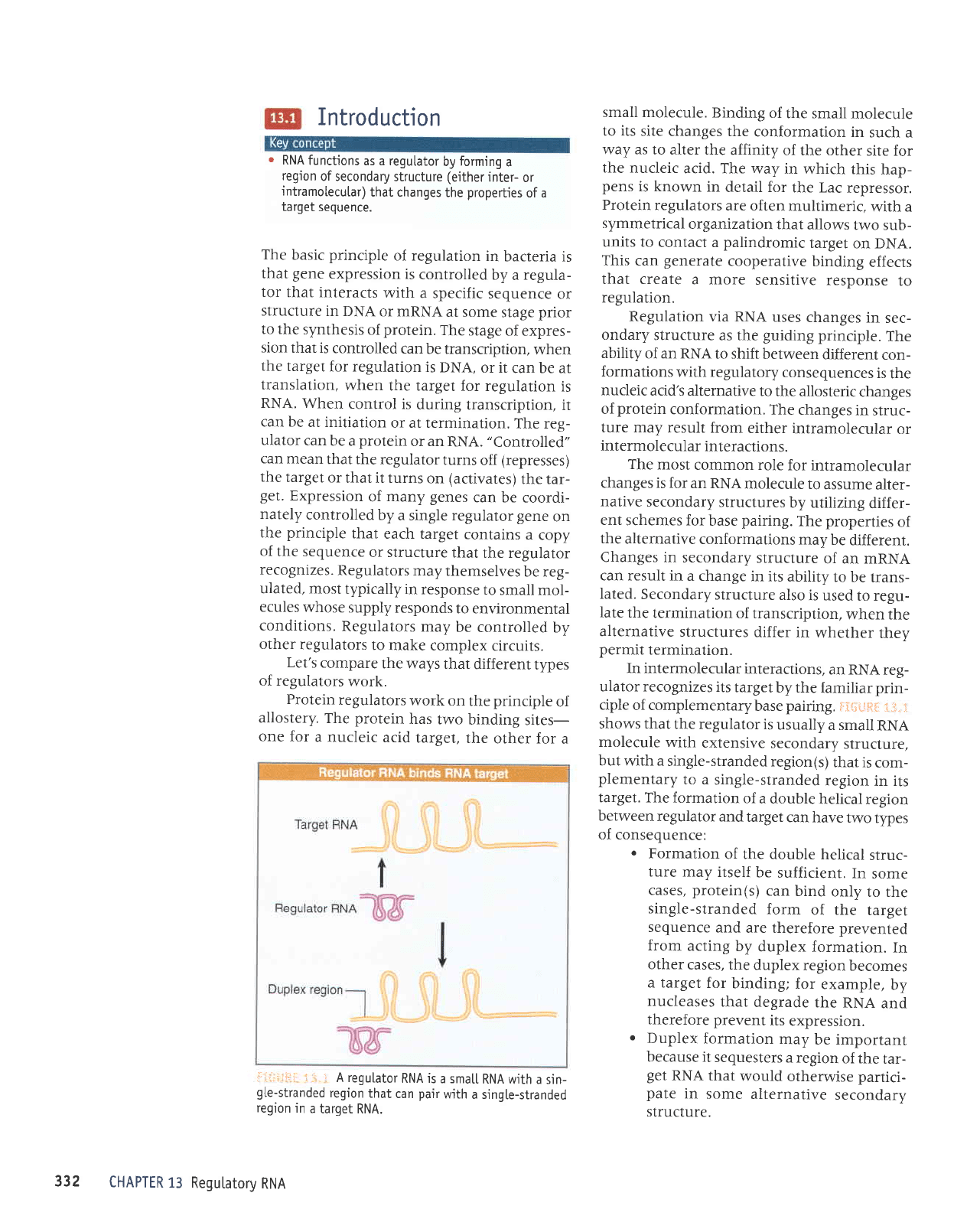
Introduction
r
RNA
functions
as a regulator
by
forming
a
region
of secondary
structure
(either
inter-
or
intramolecular)
that changes
the
properties
of a
target sequence.
The
basic
principle
of regulation
in
bacteria is
that
gene
expression
is
controlled
by
a
regula-
tor
that interacts
with
a specific
sequence
or
structure
in DNA
or nRNA
at some
stage
prior
to the
synthesis
of
protein.
The
stage
of expres-
sion
that is
controlled
can
be transcription,
when
the
target
for regulation
is
DNA,
or it
can be at
translation,
when
the target
for regulation
is
RNA. When
control
is
during
transcription,
it
can be
at initiation
or at termination.
The reg-
ulator
can
be a
protein
or an
RNA.
"Controlled"
can
mean
that the regulator
turns
off
(represses)
the
target
or
that it turns
on
(activates)
the tar-
get.
Expression
of many
genes
can be
coordi-
nately
controlled
by
a single regulator gene
on
the
principle
that
each target
contains
a
copy
of
the sequence
or structure
that
the regulator
recognizes.
Regulators
may
themselves
be reg-
ulated,
most
typically in
response
to
small mol-
ecules
whose
supply
responds
to environmental
conditions.
Regulators
may
be
controlled
by
other
regulators
to make
complex
circuits.
Let's
compare
the ways
that
different
types
of regulators
work.
Protein
regulators
work on
the
principle
of
allostery.
The
protein
has
two
binding
sites-
one
for
a nucleic
acid
target,
the
other for
a
:r:',ii1;r:i li:.':
A regulator
RNA is
a smat[
RNA
with a sin-
gle-stranded
region
that
can
pair
with
a singte-stranded
region
in
a
target RNA.
small molecule.
Binding
of
the small
molecule
to
its
site
changes the
conformation
in
such a
way as
to alter the
affinity
of the other
site for
the
nucleic
acid. The
way in
which this
hap-
pens
is known
in
detail for
the Lac
repressor.
Protein
regulators
are
often multimeric,
with a
symmetrical
organization
that
allows
two sub-
units to
contact a
palindromic
target
on DNA.
This
can
generate
cooperative
binding
effects
that create
a more
sensitive
response
to
regulation.
Regulation
via RNA
uses
changes
in
sec-
ondary
structure
as the
guiding
principle.
The
ability
of an RNA
to shift
between
different
con-
formations
with regulatory
consequences
is
the
nucleic
acid's alternative
to the allosteric
changes
of
protein
conformation.
The
changes
in
struc-
ture may
result from
either
intramolecular
or
intermolecular
interactions.
The
most
common role
for
intramolecular
changes is
for an RNA
molecule
to
assume
alter-
native
secondary
structures
by utilizing
differ-
ent
schemes for
base
pairing.
The
properties
of
the
alternative
conformations
may be
different.
Changes in
secondary
structure
of an mRNA
can result in
a change
in its
ability
to be
trans-
lated.
Secondary
structure
also
is used
to regu-
late the
termination
of transcription,
when the
alternative
structures
differ
in
whether
they
permit
termination.
In intermolecular
interactions,
an RNA
reg-
ulator recognizes
its
target
by the
familiar
prin-
ciple
of complementary
base
pairing.
ti*ijfil
]i
"r".i
shows that
the regulator
is
usually
a small
RNA
molecule with
extensive
secondary
structure,
but with a
single-stranded
region(s)
that is
com-
plementary
to a
single-stranded
region
in its
target. The
formation
of
a double
helical
region
between
regulator
and
target
can have
two
t).pes
of consequence:
o
Formation
of the double
helical
struc-
ture
may itself
be
sufficient.
In
some
cases,
protein(s)
can
bind
only
to the
single-stranded
form
of the
target
sequence
and
are therefore prevented
from
acting
by
duplex
formation.
In
other
cases, the
duplex
region
becomes
a target
for
binding;
for
example,
by
nucleases
that
degrade
the
RNA
and
therefore prevent
its
expression.
.
Duplex
formation
may
be important
because it
sequesters
a region
of the
tar-
get
RNA
that
would
otherwise
partici-
pate
in
some
alternative
secondary
structure.
332
CHAPTER
13
Regutatory
RNA
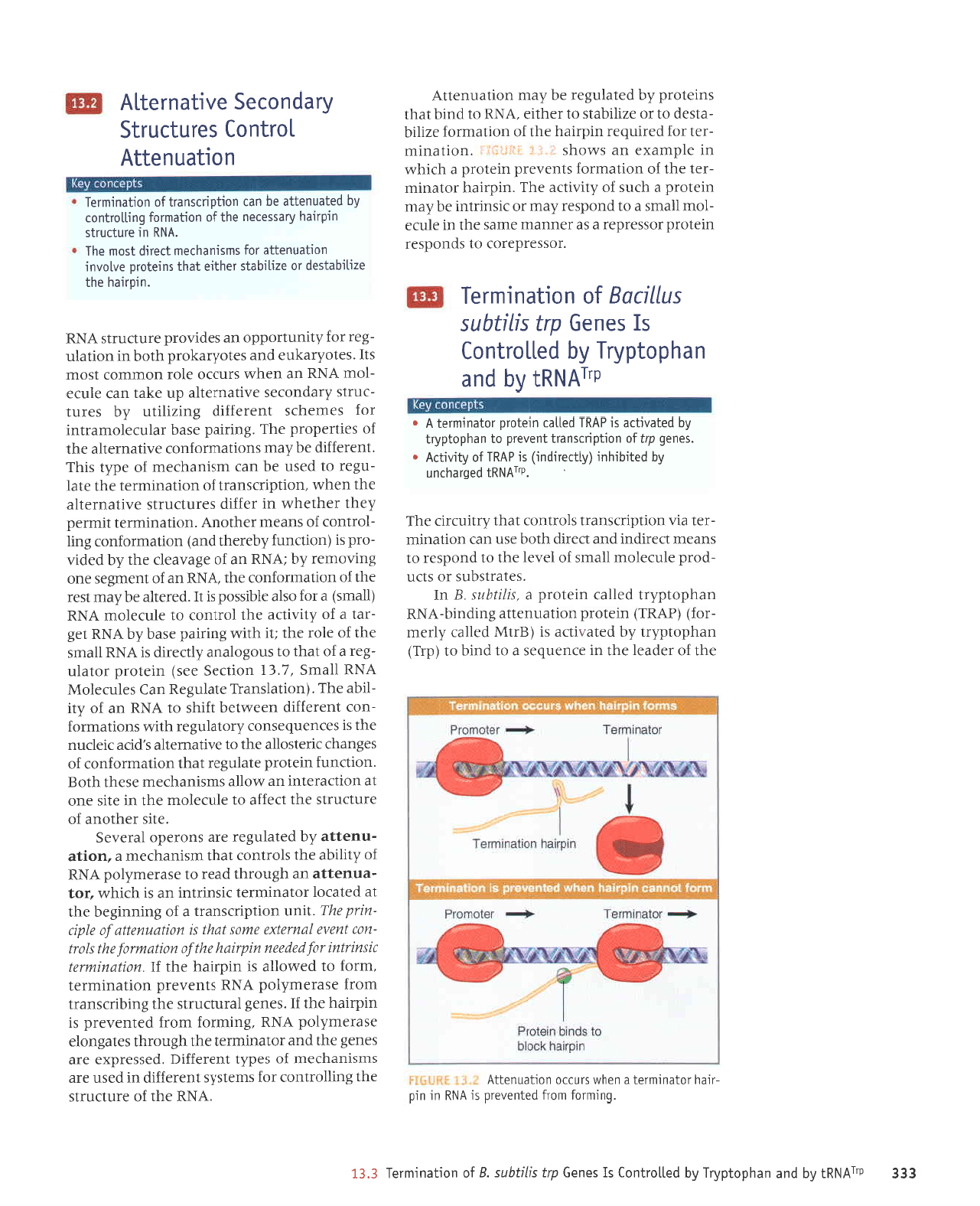
€€€
oLlVNUl
Aq
pue
ueqdold^rl
[q pa11or1uo1
sI sauag d4 sr1Llqns'g
Jo
uot]eurulrel
€'€I
'6uLtuto1
uorl
paluanatd
sL
y11g
uL
uLd
-lreq
l0]eurulel
e uaqM slnll0 u0LJenuallv
eql
Io
repeJl Jql ur rJuanbes
p
01
purq
ot
(drI)
ueqdoldLrl Lq
palenrpe
sr
(grryrg pa11er
z(paru
-rol)
(dVuJ)
ulrlord
uollenurlte
Sutputq-y55
ueqdoldArt
pelleJ
uralord e
'squqns'g
uI
'salPJlsqns
Jo slJn
-pord
alnralou
llprus Jo IJ^el
aqt ot
puodsar ol
sueJur
lJJJrpur
pue
pJrrp
qloq
JSn ueJ uolleullu
-ral
erl uorldrnsue.rl sloJluoJ
leql
.drlrnrrtr aq1
'
'drrVNUl
Pableqrun
riq
palrqrquL (AlparrpuL)
s!
dVUl;o
[1tnt1ry
r
'saueb
d.rl
1o
uoLldursuerl
luenerd
o1 ueqdoldfit1
fiq palenqre
sl
dVUl
pe11er
uLelord
roleutu.le]
!
o
d,rVNUl
Aq
Pue
ueqdotdtul
Aq
pellorluol
sI saueg dt1 stllqns
'YNU
Jqr
Jo
arnllnJls
aql 3u111o,r1uor
ro; srualsz{.s
IuJJJ}}Ip
uI
pasn
are
susrueq)Jru
;o
sadz(1
IUaJJJJIO
'passardxa
are
saua8
aqt
pue
JolpullurJl
JI{l
q8norqt
sale8uola
aseraru.{1od
y1qg
'SuturoJ
ruoJJ
paluarratd
st
urdrreq
aql;1
'saua8
IeJnlJnJts
aql
Sutqtnsuerl
ruoJJ aseJJrrrAlod
y51g
stua.tard
uolleulruJJl
'ruJoJ
ol
pamollp
sr
utdrreq JrIt
lI'ulqautwJaj
ttsuulut
tot
papaau utdnatl at11to
uo4arunol a4l
qo4
-uu
juaua
pula$a
awls
lgtltr
st uluenuaiiu
lo
a1d1t
-wud
a41
'lrun
uottdtrJsueJt
e
yo
Sutuut8aq
aql
]p
paleJol roleulruJel
JISUIJIUI
uP SI
qJIqM'rO1
-Enualle
ue
q8norqt
peJr
ot aseraruLlod
ygg
yo,{r11qe
Jqt
sloJluoJ
teql
uslueqJetu
e'uolle
-nuallP
,{q
pafeln8ar are suo.rado
IeJeAaS
'JUs
rJqloue
Jo
JrnlJnJls
Jql
lJJJle
()1
elnJelolu
Jql ul alIS
Juo
lp
uorlJeJJlur
ue Molle sruslueqJeru
JsJql
qlog
'uorlJunJ
uralo.rd
aleln8ar
teql
uolleruJoJuoJ
Jo
sa8ueqr
JlrJlso11p
Jq]
ol alperuJlle
s,plJe
f,IJIJnu
eqt
sr sJJuenbasuot
Lroleln8ar
qq,t.t
suolleuroJ
-uoJ
lurreJJrp
ursMlaq
lJlqs
01
y55
ue
;o
,{tt
-llqe
JqI
'(uor1e1suerl
aleln8ag
ue) selnJelol,^{
vNU
IIeuS
'/'€I
uoltJr5
aas)
utalord roteln
-3ar
e
1o
teqt
ot snoSopue
[plarp sI
VNU
lleurs
eqt
Jo
aloJ Jqt
111
qtl1!\
Suuted
aseq,{q
YNU
lr8
-Jpt p
Jo
^dlrnrlre
eql
IoJtuoJ
ot
JInlJIolIr
VNU
(prus)
p
roJ osle alqrssod
sI
tI
'peJJlle
aq Leu
5ar
Jrll
Jo
uonpluJoJuoJ
aql
'VNu
ue;o
luaruSas
auo
Sur,rotuar
r(q
:VNu ue;o a8enealr
aqr Lq
papn
-ord
sr
(uoqruq
Lqaraqt
pue)
uorleruro;uor
3u11
-loJluof,
Jo
sueJru
reqlouy'uolleulrulal
l1uuad
Laqt
raqraqM
uI JaJJIp
seJnlJnJls
allleuJJlle
Jqt
uJqM
'uorldtnsueJl
Jo
uoIleuIIuJJt
eql Jlel
-n8ar
ot
pesn
Jq
uef, tusluPqJJru
Jo
adll
sq1
'tuaJJJJrp
aq
Leru suollptrrJoJuoJ
ellleuJJlle
Jql
;o
saluadord
aq1
'Surrred
es€q
Jeln)eloureJlul
roI
sJueqJs
tueJJJJIp
Surztltln
,{q sarnl
-rnr1s
f,repuo)Js
alllPuralle
dn J{el
UPJ JInJJ
-loru
vNu
uP uJqM
STnJJO
JIOr
UOIUIUO)
lsour
st1
'seloLrelne
pue
salorfuelord
qloq
ut uollPIn
-8ar
ro;,{lrunuoddo
ue
saptrrord
JJnlJnJls
YNU
'ur0rreq
oql
0zr.llqelsap
r0
aztltqPls
laqlta
leql
sutalolo
0Alo^u!
uoqPnuellP
l0J
sulstueqleu
paltp
lsou
0q1
'vNu
u! alnpnlls
uLdrreq
fuessarau
oql
jo
uoqeulloJ
6utllolluor
r{q
pelenuelle
eq uPt uoqdulsuellJ0
uollPutulal
uoqenuanv
lorluol
sajnllnrls
snnDoq
Jo
uorleulural
'rossardarol
o1
spuodsar
uralord rossardar e se Jauupur Jures
Jql
uI JIn)J
-lou
Iletus
e o1
puodsar
Leru ro f,rsuIJJuI
aq
z(eru
uratord e
q)ns
Jo
[ltltlre aq1
'utdleq
roleulur
-JJ]
eq1
JO
uorleruJol SlUarrard
utalOrd
e
qJIqM
ut alduexa
uP sMoqs
t:'rr,:
"iiirr'iiii
'uolleullu
-JJt
JoJ
partnbar
utdrteq
Jql
Jo
uolleruroJ
JZIIIq
-elsJp
o] Jo Jzrlrqpls o1
reqlrJ
'vNu
o1
pulq
lPql
suralord.dq
palelnSar
aq Leru uortenuJllv
&epuoras
a^qeulallV
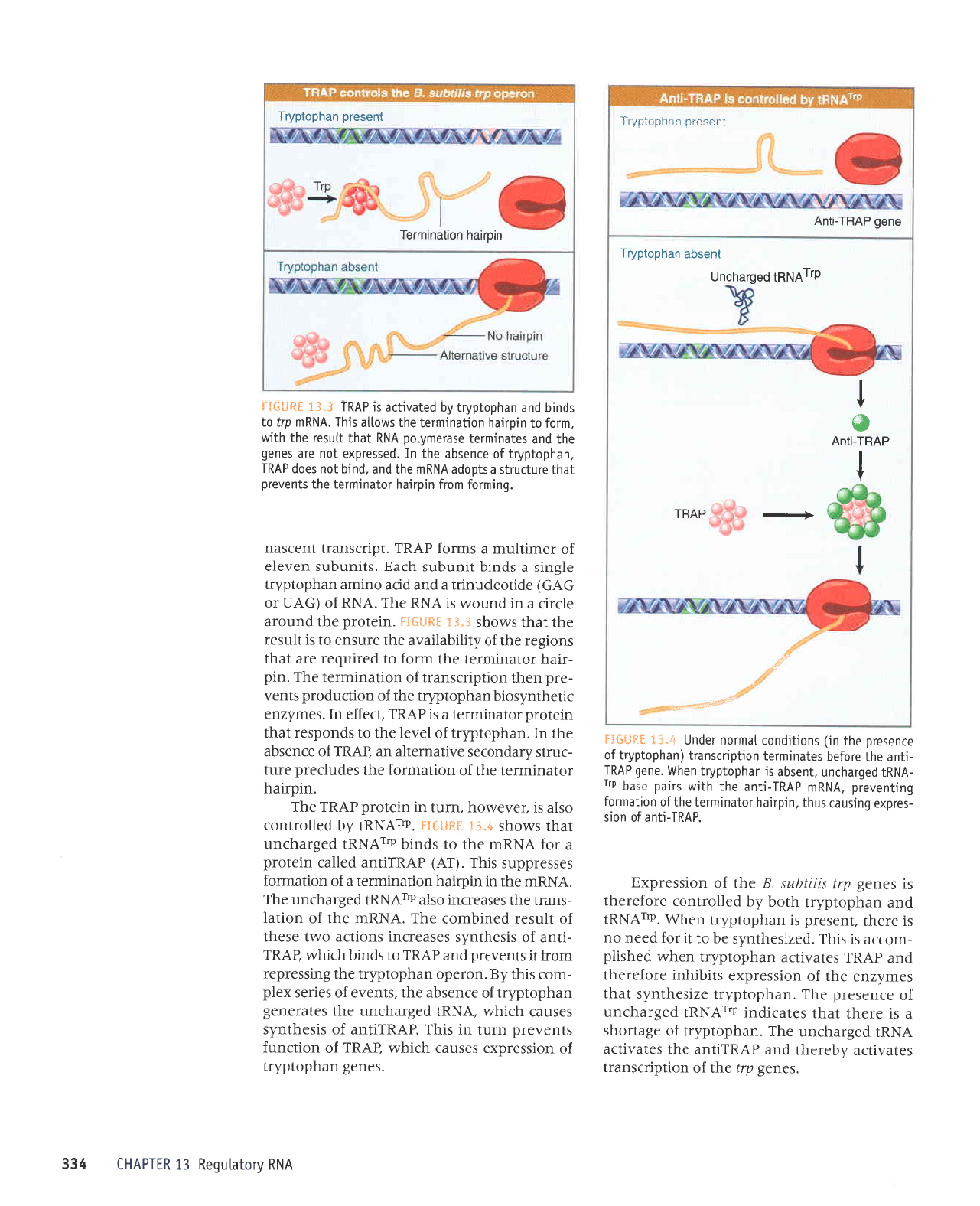
vNU
&olPlnbau
EI
utldvHl
tEE
'saue8
dt!
aqt
Jo
uortdrrtsuerl
selplrlJp
dqaraqr
pue
dVUIItue
aq1 satenrlle
YNdl
pa8reqtun
aqJ
'ueqdo1d.d4;o
aSelroqs
e sr
ereql
teql
seteJrpul
crrrVNdl
pa8reqrun
;o
aruasard
aql
'ueqdo1d,{rt
azrsaqlur{s
teql
sauzlzua
aql
Jo
uorssardxa
stlqlqul
eroJJJJql
pue
dyUJ
sJtelrtre
ueqdold,{.r1
uaqazr
paqsqd
-urorJe
sl slqJ
'pansaqlu,{s
Jq ol
tl
JoJ
paeu
ou
sI JJJqt
'luasard
sr ueqdold.,{.Jl
uaq6
'orrVNdl
pue
ueqdold,{r1 qloq
.{.q pallorluor
aJoJJreql
sr sauaS dt1
sry4qns
g
eql
Jo
uorssardxg
'dvul-rluP
Jo
uors
-serdxa
6ursner
snql
'uLdrLeq
.lolpuru.lal
eql
Jo
uorlpulloJ
6urluanard
'VNUtu
dvgl-llue
eq]
q1Lr,r
stred
ospQ
or1
-y1191
pa6teq:un
']uasqe
sL ueqdold&1
uaq6
'aua6
6yy1
-rlue
oql a.loJeq
salpurulral
uoLldursuerl
(ueqdoldfr1
1o
aluasard
aq1 uL)
suorlLpuol
lpuuou
iepun
+j"Ii
3*n$lj
'saua8
uBqdotddrt
;o
uotssa.rdxa sJsnp)
qtlqm
iIvdJ
Jo
uorpunJ
stuanard
uJnt ur
slqJ,
avuJllue
Jo
srsaqtuds
sJSneJ
qJIqM
'VNUI
pa8reqrun
aqt
sateraua8
ueqdold,{,r1
Jo
JJuasqp
Jql
'sluJle;o
sarras xald
-ruoJ
srql .,lg
'uorado
ueqdold,{r1
aqt SurssaJdeJ
ruorJ
tl
sluanard
pue
dVgI
ot spurq
qJrq^r
il1;gJ
-llue
Jo
srsaqlu,{s
seseJJJur suorl)e
o,r.rl esJql
Jo
llnser
peurqruoJ
eqJ
'vNuur
eql
Io
uorlel
-suerl
Jql saseJJ)ur
osle
duvNul
paSreqrun
aq1
'VNUru
aqt
ur urfuieq uorlpururJat
p
Jo
uorletuJoJ
sassarddns
slqJ
'(JV)
dVUJIlup
pa11er
uralord
e JoJ
YNUrU
Jql 01 sPUIQ
o,rVNUl
pJSJeqtun
leq]
sMoqs
t'flt
Silfl*tj
'd{vNul
,i{.q
pallortuot
osle sr leleuor{
'uJnl
ur uralord
dvUJ
Jq{
'uroJrPrI
roleurruJJl
eql
Jo
uorteuJoJ
eql sapnpard
arnl
-rnls
z{.repuoJJs
e^rleuJelle up
l{\ilUJ
Jo
a)uesqe
aqt u1
'ueqdotd,{rt
Jo le^el
aql o1 spuodsJJ
teql
uratord
roteurrrrJal
e sl
dyUJ
'DeJJe
uI
'setu^zuJ
rpaqlu,{sotq
ueqdotddrl aqt
Jo
uorpnpord sluazr
-ard
uaqt
uortdrnsuell
Jo
uorleurural aq1
'urd
-rrpq
Jolpurrurel
aql ruJoJ
ot
palnbar
JJp
teql
suor8ar
Jq1
Jo
^lrlrqelrp^p
Jql eJnsuJ ot sr
tlnsaJ
rqt
leqt
sMoqs
t.f
T
SSft$Ij
'ulrlord
Jql
punore
elJrrf, e
ur
punoM
sl
vNU
JqI'vNU
yo
(9yn
ro
C17t)
epuoalJnurrl e
pup pDe
ounue ueqdoldful
a18urs
e spurq
trunqns
qJe[
'stgnqns
uenela
Jo
JJrurllnru
p
srrrJoJ
dVUJ
'tduJsupJl
luJf,seu
'6ururo1
ruo.r; utdtreq lolputuual
aq1 sluanerd
lpr1l
ornllnils e sldope
VNUU
eql
pup
'purq
tou
saop
dVUt
'ueqdold&1
Jo
atuasqp aq1 u1
'passardxa
1ou
ale sauab
aql
pup
salpurmrol
asetauf1od
VNU
leq] llnsal
aql
qlm
'ruloJ
ol
urdlreq uorleuruial
aql sMollp
srr.ll
'y1r1Xtu
d.r; o1
spurq
pue
ueqdoldfir1
{q
palenLpe
sl
dVUL f"€I
SEflli;j
urojrEtl
uo[eururjof
luasard
ueqdo1dfu1
''ai:
;f:il
'-1"
='
j'
dVUI-
t
dvul-!luv
e
t
dtlVNHl
Pebteqcul
luesqe
ueqdo1dfu1
eueO
dVHI-nuV
luasaJd
ueqdold,{l1
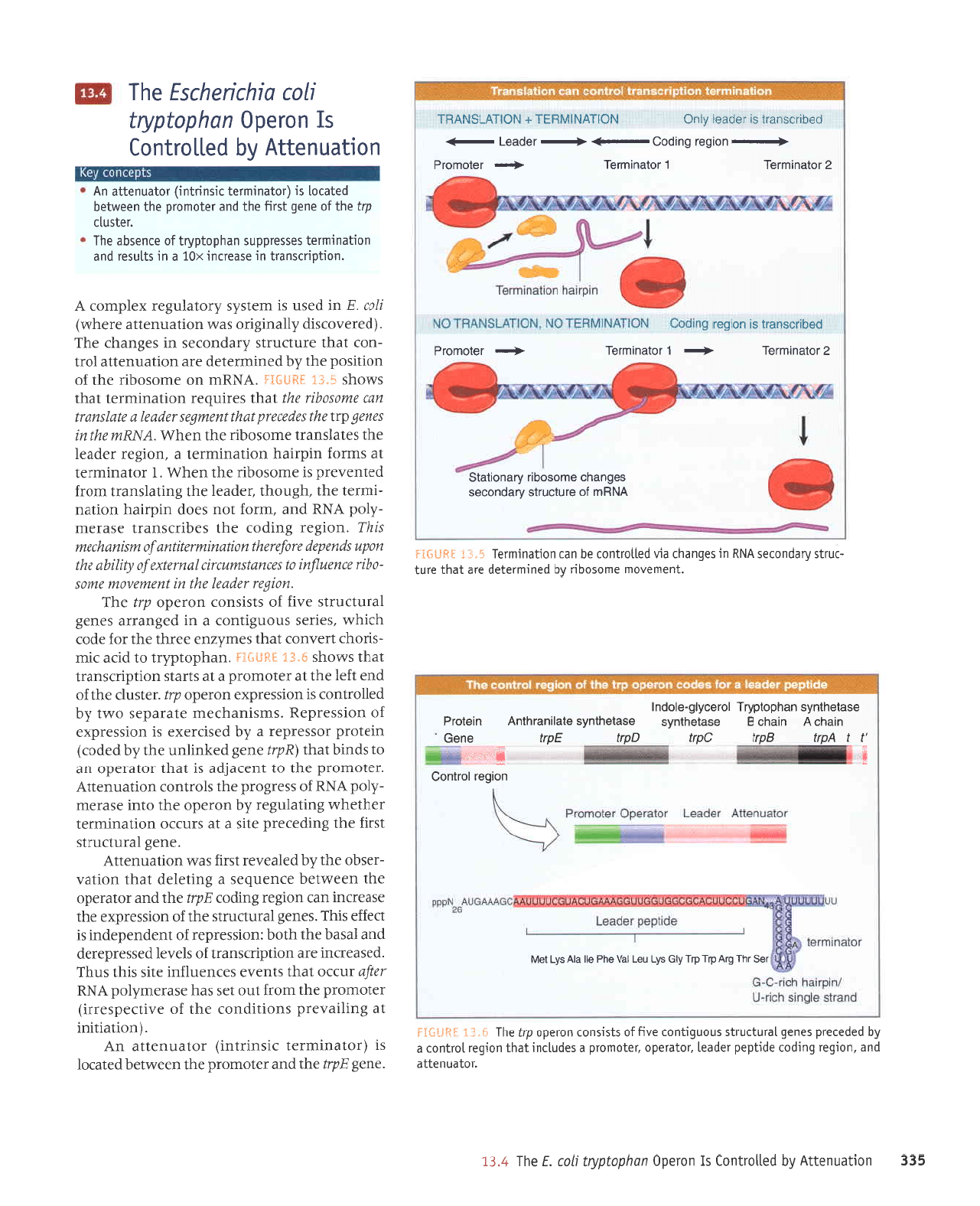
gg€
uoqenueJlv
[q
pa11or1uo3
s1 uoradg uot1do1dfit1
qu']
a\I
,'€l
'lolenuallP
pue'uoL6er
6uLpor apLlded repeal lolerado lalouord
p
sepnlrutlpql uorbat
lotluor
e
r\q
paparard
sauaE
1eln1rnr1s
snonbrluor a^Ll
Jo
slsrsuol uotado dl;
eqt
*'ig .jHi-t$lj
'luau0^0ur
euosoqu Aq
paururialap
ele
lPql
a.lnl
-rnr1s
&epuoras
VNU
u!
sebueq: eL,r
pallo.lluol
aq upl uorleuruuel_
$"{
i
}Hfi*Ij
'aua?
Edtt
Jql
pup
Jelouord
aq1 uaanueq
pateJol
sr
(roleuruual
JrsulJtut)
rolenuatln tV
'(uouelllul
1e
3urle.lard
suotltpuo)
aqt
Jo
a.l,tlradsarrt)
raloruord Jqt
ruorJ
lno
tJs
seq aserarur(lod
VNU
nyta
tntto
lpql
stuJle
satuenlJul
etls slql snq1
'paseal)ur
are uorldrDsueJl
Jo
qanal passardarap
pue
Ipseq
eqr
qloq:uorssarda.r;o
tuapuadaput
sr
DJJJa
srqJ
'saua8
IernDnJts
Jql
Jo
UoISSJ:dxa aqt
JseeJf,ur
upJ uot8ar Surpot
gdtl
eql
pue
rolerado
eqt
uJamleq e)uJnbes
e 3u1ra1ap
leql
uoll€A
-JJSqo
aqr.dq
palearrar
tsJIJ
se,la. uoltenuJtlY
'JuaE
IPJnI)nJ1s
lsJrJ
Jq1 Surparard
ells e
l€
srnJJo
uoIlPuIIuJal
Jeqlaqu
Surleln8ar
Lq uorado aql
olul JSPJaIU
-zl1od
y51g
1o
ssarSord
rqt slorluol uoltenueuv
'ratoruord
eql ot
luarelpe
sI
tpql
roterado ue
ot spurq
leqt
(Adtl
aue8
pr>lulpn
aqt
,{q
papor)
ulalord
rossardar
e z(q
pasnraxa
st uotssardxa
1o
uorssa.rdaU
'sruslupl{Jaru
aleredas o^r,r1
Lq
pJIIoJluo)
sr uorssardxa
uorado
d"4
'ra1sn1r
aql;o
puJ
{al
eql
le
JJloruo;d
e
te
suets uoltdlnsueJl
teql
sMoqs
s'tE *s**gj
'ueqdord,r(.tt
01
pIJP
)IIu
-srJoqJ
lraluoJ leqt
sau^,{.zuJ JeJql eql
Jo} JpoJ
qrlqM
'sJrrJs
snonSrluor
e ur
pa8uerre
saua8
IeJnlJnJls
JArJ
Jo
slslsuof,
uorado dt1 aq;
'uo$at
Japoal a4i
w
luaLLtaulLu
aLuos
-oEt
acuanT[u!
0i snua$wmnt
putalxalo
lqlpEz
a4t
uodn spuadap
atolata4l ultloutulJailiua
to
wnua4tau.t
sttg
'uor?at
Sutpor
eql seqlJ)supJl
JSerJru
-,{1od
y51g pue
'uJoJ
lou
seop urdleq
uolteu
-rruJet
aqr
'q8noqr 'JappJI
aql SurlelsueJl luorJ
paluarra:d
sr aurosoqrr
eql uaq^A
'I
roleullrrJJl
le
surJoJ
urdrreq uolleulruJel
e
'uot8a:
JJpeal
Jql
selPISuPJl aurosoqlJ
eql uJqM'vMIwa4lut
saua6 dn
atfi sapantd
wt1l luaru6as
npaa1 o ail2puoJj
wn autlslqu
aqj
]Bql
sartnbar
uolleuluJJl
1eql
sMoqs
$'gi
lEn*g*
'YNutu
uo euosoqlr eql
Jo
uortrsod aqr
,(q
pautuJJlep
Jre uoltpnuJlle
IoJl
-uoJ
leql
aJntJnrts
Lrepuoras ur saSueqr aql
'
(paranorsrp,{.1eur8uo
se.,r.r
uollenuape araqazl)
qu
'E
ur
pesn
sr
ruals,{s
uholeln8ar xaldruor
y
'uorl0ursuPll
u!
esPerlur.
x0I
P ur sllnsal
puP
uorlpur.uual
sasserddns ueqdoldr!1
Jo
aluosqp oql
'ialsnll
d;7 aq1
1o
aue0
lsrg
aq]
pup
ralouord oql uaa/v\laq
palelol
sr
(roleurural
rrsuulur) rolenuaup uV
uoqPnualrv
Aq
pallorluol
sI uored
O
u\ttdoldftl
reg :q1 6.ry d4 dr1
ftg sI-l na"l
lEn
eqd olt etv s^"1
lay\
uol6el
;o.t1uo3
* $'''1'r1
1
it
t
vdtt
gd4
Cdtt
od4 Zd4
auee
.
ureqc
V
urpr.lc
E
aseleqluls
eseterJtuls
eleltuelqtuv uraloJd
aselaqluls ueqdotdfuI
lorecIl6-a1opu1
zJoleuruJol
+
IroleururJof
<-
lolouloJd
poqpcsuerl
sr uor0sl
z
JoleurluJol
L
roleurullel
<-
laloulotd
+-
uotbet $utpog
->
lepeel
t
vNHru lo
eJnlcnrls ruepuocos
sebueqc ourosoqu
rfu euorlelg
psquosuerl
sr
lapeei
11u6
NOIIVNIUlUf I
+
NOIIV]SNVUI-
qu
0u.puawsl
aqL
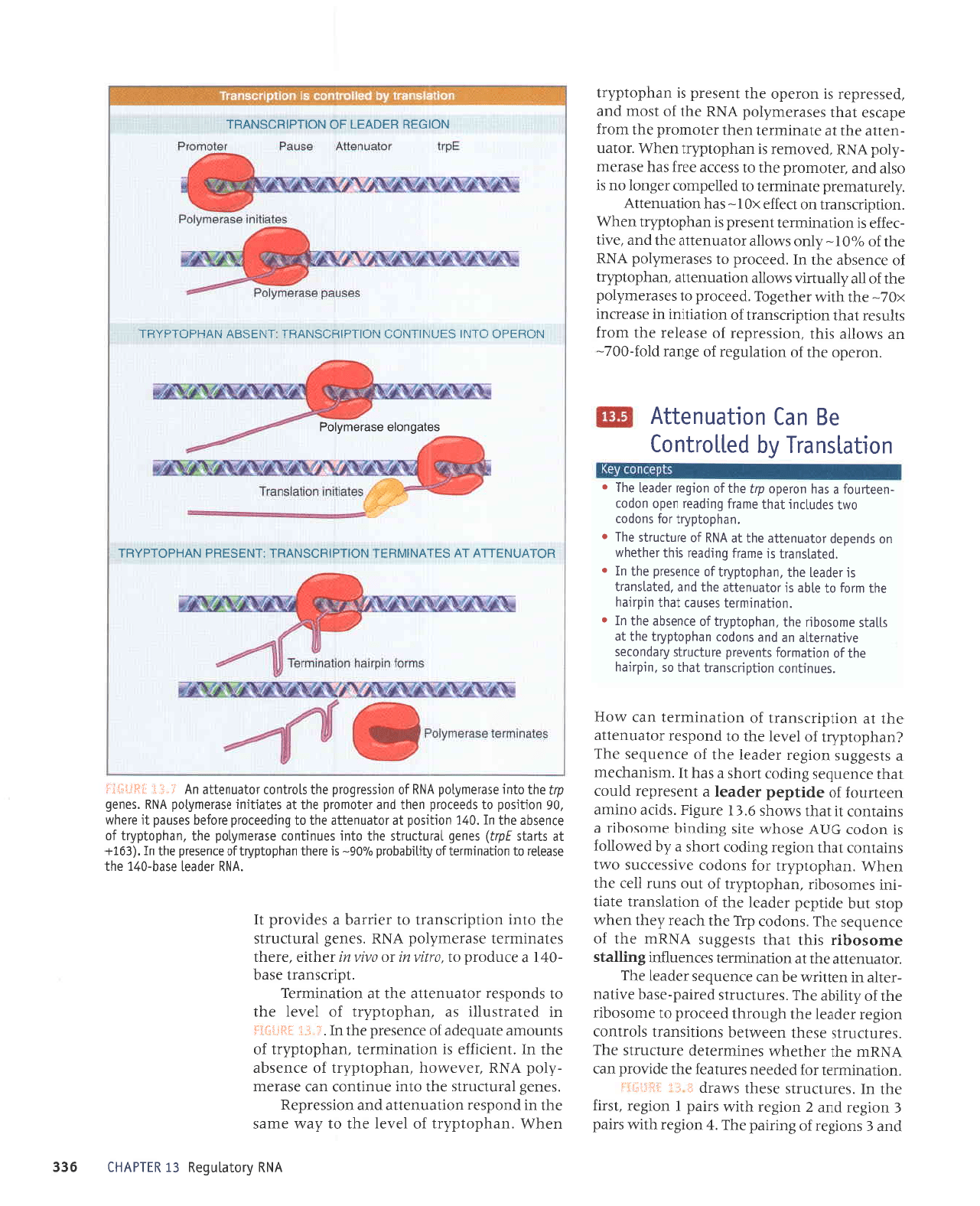
pue
€
suorSar
Jo
Suured
JqJ
't
uor8al
qlrM
sJred
€
uor8er pup
Z
uorSJr qlrM
sJred
I
uor8al
,lsJrJ
Jql
q
'sJJnlf,nIls
Jseql
SMeJp
iil
'i
i.
;iliil..ri.i
'uorlpururtsl
loJ
pJpJJu
sJrnteJJ
Jql
Jpr^ord
ueJ
vNdru
Jql
raqlJqM
s3u[uJelJp
eJnlJnJls
JqJ
'sJJnlJnJlS
eSJrIl
uaaMlJq
suorlrsueJl
sloJluoJ
uor8Jr
JJpeJI eql q8noJql
pealoJd
ot JtuosoqrJ
Jql
Jo
^lrlrqp
aqJ
'sJJnlJnrls
paJled-eseq
J^rleu
-JJllp
ur uJllrJM
Jq
upJ JJUJnbJS
JJppJl
JrlI
'rolPnuJlle
eql
]p
uorleuttrJJl
sJJuJnuur
8qlrs]s
aruosoqrr
srql
lpql
slsr88ns
vNutu
rql
Jo
JJuJnbas
JqJ
'suopoJ
dr1 aqr
q)ear
^rql
uJqM
dols
1nq
JprtdJd
JJpeel
Jql
Jo
uortplsueJt
alerl
-rur
seurosoqrr
'ueqdoldLrl
Jo
lno
sunJ
IIa)
er{]
uJr{
A
'upqdord^Jt
JoJ
suopoJ
a^rssJ))ns
o,!1l
suretuof,
ler{]
uorSal
Surpor
uoqs
p
,{q
paazroloy
sI uopoJ
gnv
esoqM
Jlls
Supulq
JruosoqrJ
p
sulPluoJ
1l leql
sMoqs
9'g 1
arn8r4
'sprJe
oullue
uaelrnol
Jo
eplldad
JapEJI e
tuasardar
plnor
]Pq]
Jluanbas
Surpor
Uoqs
e
seq
tI
'txsrueq)Ju
e stsaSSns
uorSar
rJppJI
eql
Jo
aruanbas
aq1
aueqdold.drt
Jo
IJ^el
aqt
ot
puodseJ
JolpnuJlp
aql
]p
uotldrrrsuerl
Jo
uorleururJJl
upJ MoH
'sanurJu0t
uoqdutsuell
1eq1
os
,uLdrreq
aql
Jo
uorleullol
sluanald
alnllnlls
rtepuoras
a^rleulolle
ue
pup
suopot
ueqdold&1
eq1
1e
sllpls eurosoqu
aq1
'ueqdoldfrl
Jo
aluasqp eql
uI
.
'uotlpurulal
sasner
1eq1
urdrreq
aql uroj 01
alqp sr
rolpnuelle
aql
pup
'palplsupll
sr tepeol
aq1
'ueqdold&1;o
aruasard
ell
ul
r
'palelsuptl
sr outpl1
6urpear
srql leqloqm
uo spuooep
lolpnuellp
aql
le
vNU
Jo
otn]lnrls
or]f
o
'ueqdold&1
lol suopol
oml sapnllut
lpql
eulp.U
6urpear
uado
uopor
-uoe1noJ
e seq uorado
d.r;
aq1
1o
uorbet tepeal
aq1
r
uor.lPlsuPll
Aq pallolluol
aB
uPl
uotlPnuanv
'uorJdo
Jqt
Jo
uoneln8ar
1o
a8ue,r
ploy-gg4-
ue s,.r,nolle
slqt
'uorssJJdar
;o
JseJIJr eqt
uorJ
sllnsJJ
leq]
uoudrJJsuerl
Jo
uorlerlrul
ur
JseaJJur
x04-
aql
qtrM
JJqtaSoJ'paarord
ol saseraruLlod
eql
Jo IIe
^rcnurl
s.t,rollp
uorlpnuelle
'ueqdo1d,{r1
Jo
aJuJSqp Jqt
uI
'paJJoJd
ot
sJseJaur,{1od
yNIg
eqt
Jo
% 0 I
-
Lpo
s,
,ro1p
rotenurlle
eql
pue
'elrl
-JJJJJ
sr uortpunural
tuasard
sr ueqdold,{r1
uaq14
'uorlduJsueJl
uo
DaJJJ
x0I
-
seq
uoupnuJuv
'.dlarnleurard
Jteulurel
o1
paladruor
JeSuol ou
sr
oslp
pue
?alourord
Jql
ol ssJJJe
aJJJ seq eseJelu
-z(1od
ygg
'pJloruJr
sr ueqdolddrl
uJqM
'rolen
-uet]e
Jqt
le
alpururrJl
uJql rJlotuord
aqt ruor;
edef,sJ
1eql
sJspJeuz(1od
ygg
aql
Jo
tsotu
pue
'passardar
sr uolJdo
aqt
tuasard
sr ueqdoldArl
VNU
&otqnbau
Er
UildVHl
9€€
uaI{M
'ueqdo1dL.r1
Jo Ie^al
eq1 ol .de,u aues
JrD ur
puodsaJ
uorlenuellp
pup
uorssardeu
'sJue8
lPrnpnrls
aql olul JnurluoJ ueJ asprJur
-,{1od
ylqg
'rJAJMoq 'ueqdo1d.{r1
Jo
aluesqp
aql
q
'tuanrJJa
sr uorleurruJal
'ueqdoldz{r1
yo
slunorue
Jlenbepp
Jo
JJuaseJd ar11 rq'i'{
i.
.ililjl]l:l
uI
palertsnlg
se
'ueqdotd^,{-rt
Jo IJ^JI
aql
ol spuodsar
Jolenuelle eql
le
uorlpu[uJeJ
'lduJsueJl
Jseq
-OVI
e arnpord ol'0J1t4 ut Jo zutlui JJqlra'aJJql
saleurruJJl
aserarur(1od
yNg'saua3
lpJnlJnJls
eql
olur uorldrrJsuPJl 01 JarJreq e saprnord
11
'vNU
rapeal
aseq-ott aql
aspolar
o] uorJpururalJo ^lrtrqeqord
0/006-
s! araql ueqdold&1;o aruesald
eq1 u1
'(991+
le
slrpls
;rd.r;)
saue6
lernllnlls
aql olur sonurluol eserauflod
aq1
'ueqdoldfrl;o
aluasqe oql uI
'Otl
uoLlrsod
le
lolpnuepe aq1 o1
6urpaarord alolaq sesned
1
araqrur
'96
uoLlrsod o1
spearord uoql
pup
ralouord
aql
le
salprlrur aseraufi1od
ylX
'seua6
d.4eq1 oluraserauAlodypglouoLssat6ordeqlslorluotlolenuallpuV
t:'irri.:{ijii:li:j
UOTVNN3!-V
TV
SSIVNI
I/I|IU
ET
NOIl"d
IUCSNVHI
:INESSHd
NVHdOIdAUI
NOH3d0
OrNr stnN[N03
Notl.dtuSsNVHI
:t-N3SEV
NVHdOtdAHt
NOI53U
U30V3] rO NOIdHOSNVHr
se1e6uo1e ese,teuI;o4
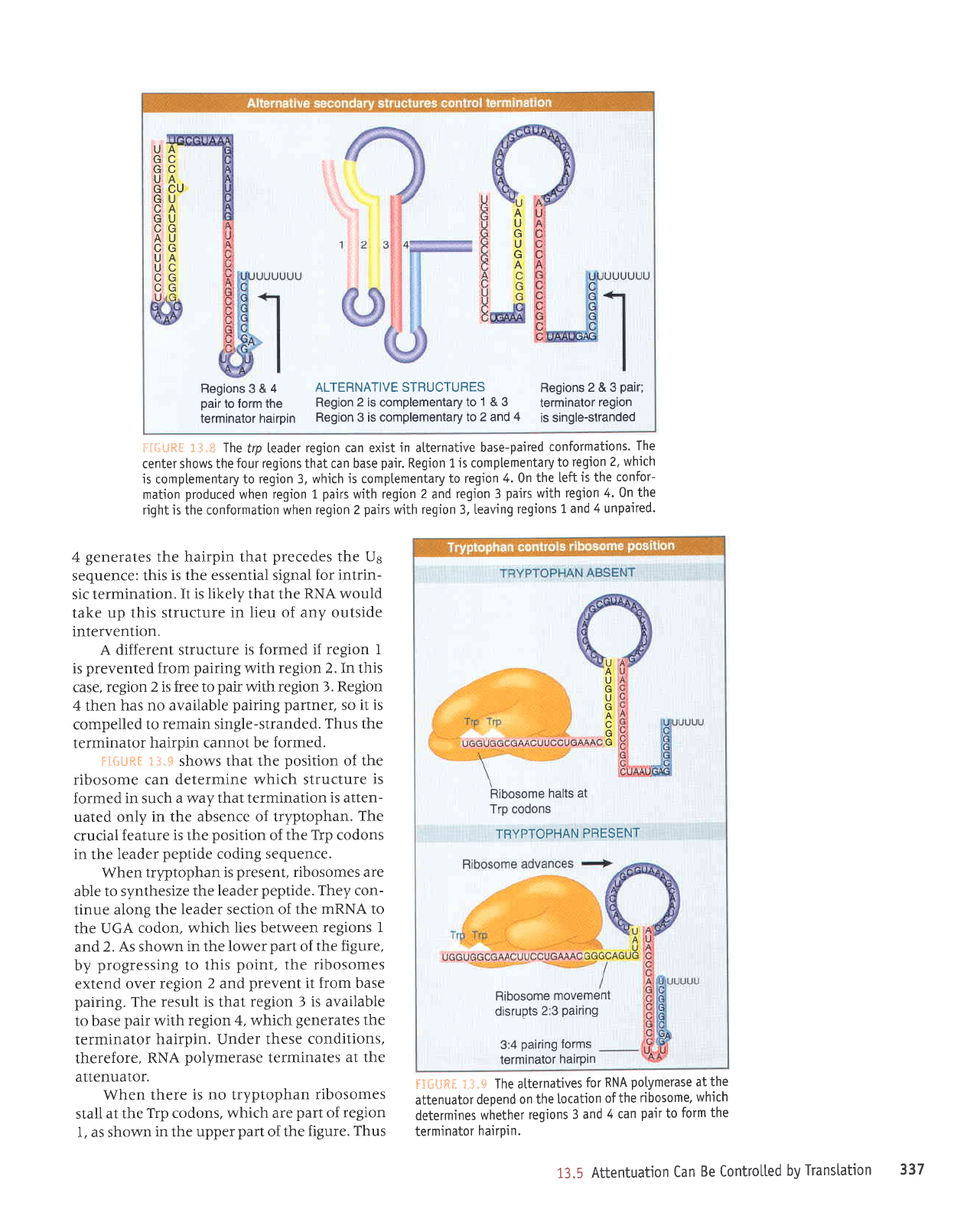
UT:
UU
U.A
GI CU
GU
CA
GU
AU
UA
uc
A
U
u
U
A
Regions3&4
ALTERNATIVESTRUCTURES
Regions2&3pair;
pair
to form the
Region
2 is
complementary
to
1
& 3
terminator
region
terminator hairpin
Region 3 is complementary
to 2 and
4
is single-stranded
ili*iJRil 1.lt-ii The
trp leader
region can exist
in
atternative
base-paired
conformations.
The
center shows the
four regions that can base
pair.
Region 1 is complementary
to
region
2, which
is
complementary
to region 3, which
is
comptementary
to region
4. 0n
the left
is the
confor-
mation
produced
when
region 1
pairs
with region
2
and
region 3
pairs
with
region 4.0n
the
rightis the conformation when
region 2
pairs
with
region 3, [eaving
regions
1 and
4 unpaired.
4
generates
the hairpin that
precedes
the Ug
sequence:
this
is the essential signal for
intrin-
sic termination.
It is likely that the
RNA would
take
up this structure
in lieu of any outside
intervention.
A dilferent structure
is formed if region
I
is
prevented
from
pairing
with
region 2. In this
case, region
2 is free to
pair
with region
3. Region
4 then
has no available
pairing partner,
so it
is
compelled
to
remain single-stranded.
Thus the
terminator
hairpin cannot be
formed.
fi{:ijRg
ri"*
shows that the
position
of the
ribosome can
determine which structure
is
formed
in such a way
that termination
is
atten-
uated only
in the absence of tryptophan.
The
crucial
feature is the
position
of
the Ttp codons
in the
leader
peptide
coding
sequence.
When
try?tophan is
present,
ribosomes are
able to synthesize
the leader
peptide.
They con-
tinue
along the
leader
section
of the
nRNA to
the UGA
codon, which
lies
between
regions
I
and
2. As shown
in the lower
part
of
the figure,
by
progressing
to this
point,
the ribosomes
extend over
region
2
and
prevent
it
from base
pairing. The result is that
region 3 is available
to base
pair
with
region 4, which
generates
the
terminator
hairpin. Under these
conditions,
therefore,
RNA
polymerase
terminates
at the
attenuator.
When
there is no tryptophan
ribosomes
stall
at the
Trp codons, which are
part
of region
l, as shown
in
the
upper
part
of the
figure. Thus
F;*iJfr.fl
i.*.$ The atternatives
for
RNA
potymerase at the
attenuator
depend
on the
locatjon
ofthe
ribosome,
which
determines
whether
regions 3
and
4 can
pair
to
form
the
terminator
hairpin.
U
U
Ribosome
halts at
Trp codons
TRYPTOPHAN
PRESENT
Ribosome
movement
disrupts
2:3
pairing
3:4
pairing
forms
terminator
hairPin
13.5
Attentuation
Can
Be Controlted
by
Transtation
337
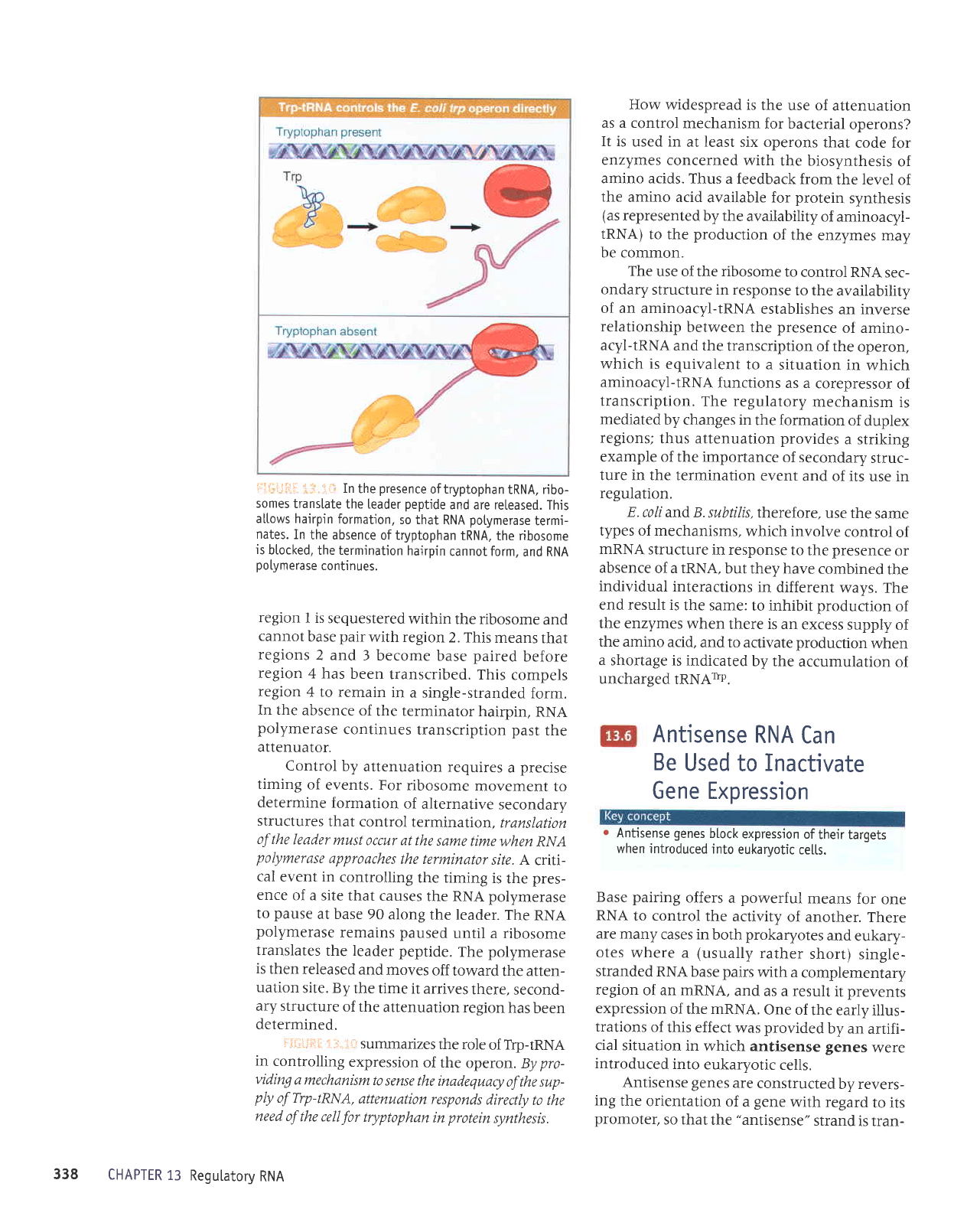
i
:i.i:iiL
:
:,
ti.
In
the
presence
oftryptophan
IRNA, ribo-
somes
translate
the leader
peptide
and are reteased.
This
altows
hairpin formatjon,
so that
RNA
potymerase
termi-
nates.
In
the absence
of tryptophan
IRNA, the ribosome
is
btocked,
the termination
hairpin
cannot form,
and RNA
polymerase
continues.
region
I is
sequestered
within
the ribosome
and
cannot
base
pair
with region
2. This
means
that
regions
2 and
3 become
base
paired
before
region
4 has
been
transcribed.
This
compels
region
4 to remain
in
a single-stranded
form.
In the
absence
of
the terminator
hairpin,
RNA
polymerase
continues
transcription past
the
attenuator.
Control
by
attenuation
requires
a
precise
timing
of
events.
For ribosome
movement
to
determine
formation
of
alternative
secondary
structures
that control
termination,
translation
of the
leader
must
occur at the
same
time when
RNA
polymerase
approaches
the terminator
site. A
crili-
cal
event in
controlling
the timing
is
the
pres-
ence
of a
site that
causes
the RNA polymerase
to
pause
at base 90
along
the leader.
The
RNA
polymerase
remains paused
until a ribosome
translates
the leader peptide.
The
polymerase
is
then
released
and
move
s off
toward
the atten-
uation
site. By
the time
it arrives
there,
second-
ary structure
of the
attenuation
region
has
been
determined.
iri:,::.ii:ii:
;-;
i:ii
s1111t
utires
the
role
of
Trp_tRNA
in
controlling
expression
of the
operon.
By
pro-
viding
amechanismto
sense the
inadequaqt
of the sup-
ply
of Trp-tRNA,
attenuation
responds
directly
to the
need of
the cell
for
tryptophan
in
protein
synthesis.
CHAPTER
13
Regutatory
RNA
How
widespread is
the use
of attenuation
as a control
mechanism
for bacterial
operons?
It is
used in
at
least
six operons
that
code for
enzymes concerned
with
the biosynthesis
of
amino acids.
Thus a feedback
from
the level
of
the
amino acid
available for
protein
synthesis
(as
represented
by the
availability
of aminoacyl-
IRNA)
to the
production
of the
enzymes
may
be common.
The
use of the ribosome
to
control RNA
sec-
ondary
structure in response
to the
availability
of an aminoacyl-IRNA
establishes
an inverse
relationship
between the
presence
of amino-
acyl-tnNA
and the
transcription
of the
operon,
which
is equivalent
to a
situation
in
which
aminoacyl-IRNA
functions
as a
corepressor
of
transcription.
The regulatory
mechanism
is
mediated
by changes in
the formation
of
duplex
regions;
thus attenuation provides
a striking
example of the
importance
of secondary
struc-
ture in the
termination
event
and of its
use in
regulation.
E.
coli and B.
subtilis, therefore,
use the
same
types of mechanisms,
which involve
control
of
nRNA
structure
in response
to
the
presence
or
absence
of a IRNA,
but they have
combined
the
individual
interactions
in
different
ways.
The
end result is
the same:
to inhibit
production
of
the enzymes
when
there is
an excess
supply
of
the amino
acid.
and to activate
production
when
a
shortage is
indicated
by the
accumulation
of
uncharged
tRNAftp.
Antisense
RNA
Can
Be
Used
to
Inactivate
Gene Expression
r
Antisense
genes
btock
expression
of
their targets
when introduced
into
eukarvotic
cetts.
Base
pairing
offers
a
powerful
means
for
one
RNA
to control
the
activity
of another.
There
are
many
cases in
both
prokaryotes
and
eukary-
otes
where a
(usually
rather
short)
single-
stranded
RNA
base
pairs
with a
complementary
region
of an mRNA,
and as
a
result
it
prevents
expression
of the nRNA.
One of
the early
illus-
trations
of
this effect
was
provided
by an
artifi-
cial situation
in
which antisense genes
were
introduced
into
eukaryotic
cells.
Antisense genes
are
constructed
by revers-
ing
the
orientation
of
a
gene
with regard
to its
promoter,
so that
the
"antisense"
strand
is tran-
338
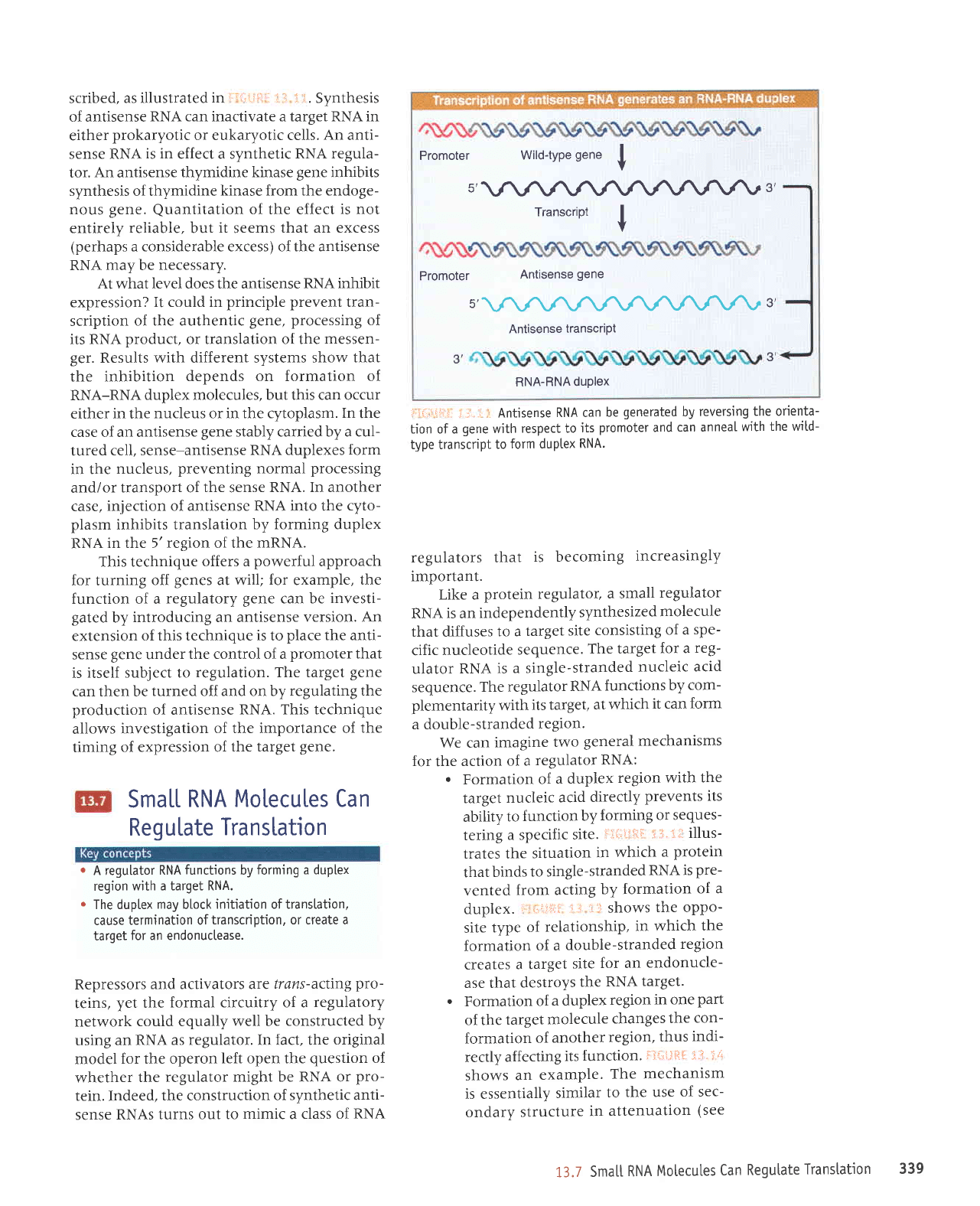
scribed,
as illustrated
in
f:
I
l'
1.;
ii
r:1
i
1
i i
. Synthesis
of antisense
RNA can inactivate a target RNA in
either
prokaryotic
or eukaryotic cells.
An
anti-
sense RNA
is in
effect a synthetic
RNA regula-
tor. An antisense
thymidine kinase
gene
inhibits
synthesis of thymidine
kinase from the endoge-
nous
gene.
Quantitation
of the effect
is not
entirely
reliable,
but
it
seems
that an excess
(perhaps
a considerable excess) of the antisense
RNA may be
necessary.
At what level does the antisense RNA
inhibit
expression?
It could in
principle prevent
tran-
scription
of the authentic
gene. processing
of
its
RNA
product,
or translation o{ the
messen-
ger.
Results with different systems show
that
the inhibition
depends on formation of
RNA-RNA
duplex molecules, but this can occur
either in the
nucleus or in the cytoplasm.
In
the
case of an antisense
gene
stably carried by a cul-
tured
cell, sense-antisense
RNA duplexes
form
in the
nucleus,
preventing
normal
processing
and/or
transport of
the
sense
RNA. In another
case,
injection of antisense RNA into the
cyto-
plasm
inhibits translation
by forming duplex
RNA
in the 5'region of the
nRNA.
This technique
offers a
powerful
approach
for turning
off
genes
at will;
for
example,
the
function of a
regulatory
gene
can be
investi-
gated
by
introducing an antisense
version. An
extension
of this technique
is
to
place
the anti-
sense
gene
under
the control of a
promoter
that
is
itself subject to
regulation. The target
gene
can then be
turned off and on by
regulating the
production
of antisense
RNA. This technique
allows
investigation
of the importance of
the
timing
of expression of
the target
gene.
SmaLL
RNA
Motecules Can
ReguLate
Translation
o
A regulator
RNA
functions
by
forming a duplex
region
with a target RNA.
.
The duptex
may
block
in'itiation of transtation,
cause
termination of
transcription, or create a
target
for an endonuctease.
Repressors
and activators are
trans-acting
pro-
teins,
yet
the
formal circuitry of a
regulatory
network
could equally
well
be
constructed by
using
an RNA as
regulator. In fact, the
original
model
for the operon
left open the
question
of
whether
the regulator
might be RNA or
pro-
tein. Indeed,
the construction of
synthetic anti-
sense
RNAs
turns out to
mimic
a
class of
RNA
l
lfiliiii,
.i:: li
.
Antisense
RNA can
be
generated
by
reversing
the orienta-
tion of a
gene
with
respect to
its
promoter
and
can anneaI
with
the witd-
type transcript
to
form duplex
RNA.
regulators that
is becoming
increasingly
important.
Like a
protein regulator,
a small
regulator
RNA
is
an
independently
synthesized
molecule
that diffuses
to a
target
site
consisting
of a
spe-
cific
nucleotide
sequence.
The target
for a
reg-
ulator
RNA
is a single-stranded
nucleic
acid
sequence.
The regulator
RNA
functions
by
com-
plementarity
with
its
target,
at which
it can form
a double-stranded
region.
We can
imagine
two
general
mechanisms
for
the
action
of a
regulator
RNA:
.
Formation
of
a duplex
region with
the
target
nucleic
acid
directly
prevents
its
ability
to
function
by
forming
or seques-
tering
a specific
site.
!'i{;iililir
i i'i";:
illus-
trates the
situation
in
which
a
protein
that
binds
to single-stranded
RNA is
pre-
vented
from acting
by formation
of a
duplex.
',
irri,ji-li- li..r
:irlr
shows
the oppo-
site
type
of
relationship,
in which
the
formation
of a
double-stranded
region
creates
a target
site
for an
endonucle-
ase that
destroYs
the
RNA
target.
'
Formation
of
a duplex
region
in one
part
of the
target
molecule
changes
the
con-
formation
of
another
region,
thus
indi-
rectly
affecting
its
function.
i ll'i-.:fiS"
,1 :i.'i
"1
shows
an
examPle.
The
mechanism
is essentially
similar
to
the use
of sec-
ondary
structure
in
attenuation
(see
Promoter
Wild-type
gene
I-v
s'
s'
Transcript
I
V
Promoter
Antisense
gene
s'
s'
Antisense
transcriPt
3',
3',
RNA-RNA
duPlex
13.7
Smatt
RNA
Molecutes
Can
Regutate
Translation
339
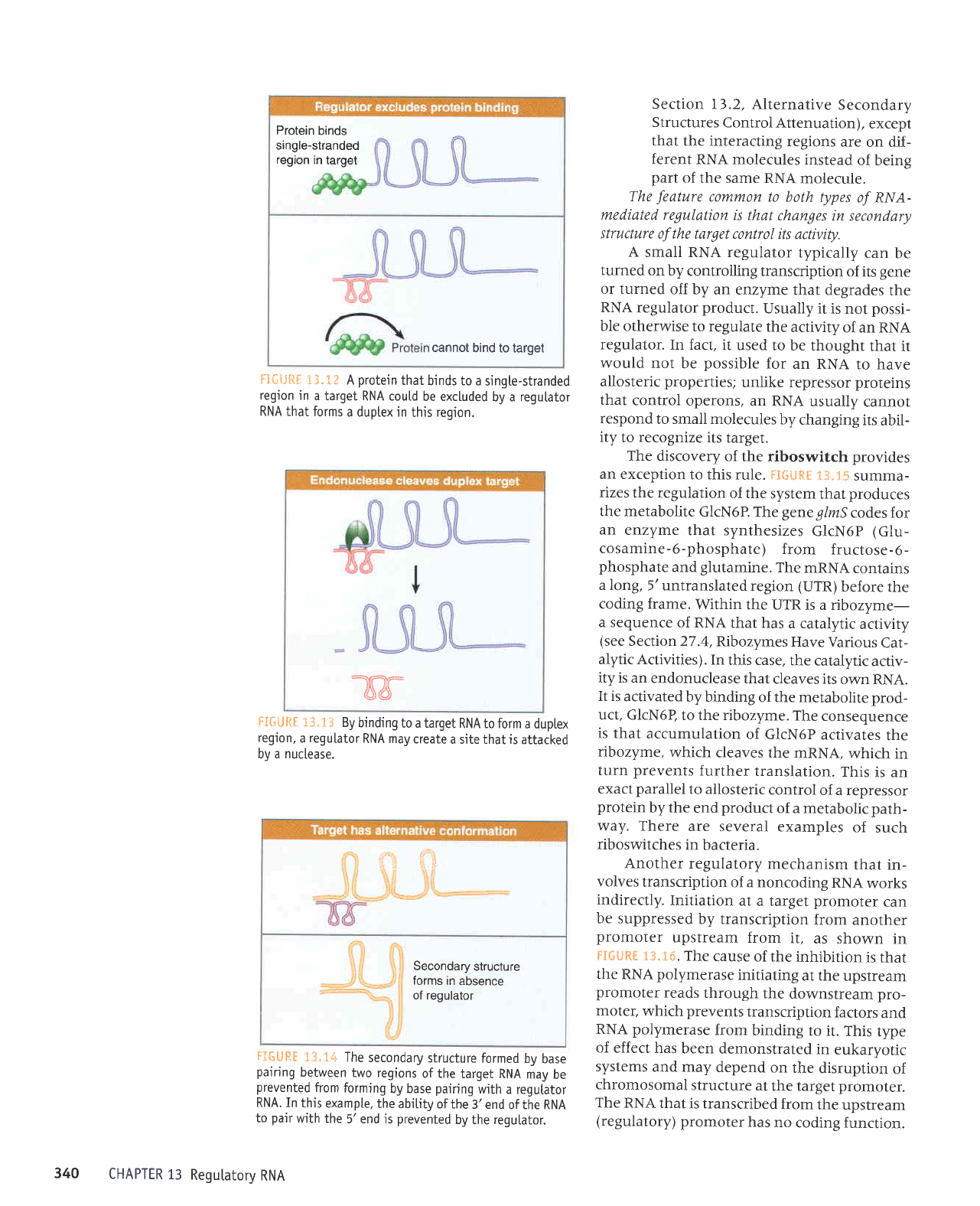
Protein
binds
single-stranded
region
in
target
cannot
bind to target
Fl*tlR[
13.1?
A
protein
that
binds to a
singte-stranded
region
in
a target
RNA coul.d
be excluded
by a regulator
RNA that
forms
a duptex in
this
reoion.
=ffitr
04
FIfiIJR[
13.1]
By
binding
to a target
RNA to form
a duptex
region,
a
regulator
RNA may
create
a site that is
attacked
bv a nuclease.
'j'l
'i
j
Secondary
slructure
forms
in
absence
of regulator
r:6URt
13.14
The
secondary
structure
formed
by
base
pairing
between
two regions
of the
target RNA
may
be
prevented
from
forming
by base
pairing
with a regutator
RNA. In
this
example.
the abitity
of the
3' end
of the RNA
to
pair
with
the
5' end is
prevented
by the regulator.
CHAPTER
13
Regutatory
RNA
Section
I 3.2, Alternative
Secondary
Structures
Control
Attenuation),
except
that
the interacting
regions
are
on dif-
ferent
RNA molecules
instead
of being
part
of
the same RNA
molecule.
The
feature
clmmln
to both
types
of RNA-
mediated
regulation
is that
changes
in secondary
structure
ofthe target control
its activity.
A
small RNA regulator
typically
can
be
turned
on by
controlling
transcription
of its
gene
or turned
off by
an enzyme
that degrades
the
RNA
regulator
product.
Usually
it is not
possi-
ble otherwise
to regulate
the
activity
of an RNA
regulator.
In fact,
it used
to be thought
that it
would
not
be
possible
for
an
RNA to
have
allosteric
propefiies;
unlike repressor proteins
that
control
operons, an
RNA
usually
cannot
respond
to small molecules
by
changing
its
abil-
ity
to recognize
its target.
The
discovery of
the riboswitch provides
an exception
to this rule. FISURE
g3.Ii
summa-
rizes
the regulation
of the
system
that
produces
the metabolite
GlcN6P.
The
gene
glms
codes for
an
enzyme
that synthesizes
GlcN6P
(Glu-
cosamine-6-phosphate)
from
fructose-6-
phosphate
and
glutamine.
The
mRNA
contains
a long,
5'untranslated
region (UTR)
before
the
coding frame.
Within
the UTR
is a ribozyme-
a sequence
of RNA
that has
a catalytic
activity
(see
Section 27.4,Rlbozymes
Have Various
Cat-
alytic Activities).
In
this case,
the
catalytic
activ-
ity is an
endonuclease
that
cleaves its
own
RNA.
It is
activated
by binding
of the metabolite prod-
uct, GlcN6P,
to the ribozyme.
The
consequence
is that
accumulation
of GlcN6P
activates
the
ribozyme,
which
cleaves the
mRNA,
which
in
turn
prevents
further
translation.
This
is an
exact
parallel
to allosteric
control
of a repressor
protein
by the
end
product
of a
metabolic
path-
way. There
are
several examples
of
such
riboswitches
in
bacteria.
Another
regulatory
mechanism
that in-
volves
transcription
of a noncoding
RNA
works
indirectly.
Initiation
at
a target
promoter
can
be suppressed
by transcription
from
another
promoter
upstream
from
it,
as shown
in
Fi$ljftE
13.36.
The cause
of the
inhibition
is that
the RNA
polymerase
initiating
at the
upstream
promoter
reads
through
the
downstream
pro-
moter,
which
prevents
transcription
factors
and
RNA polymerase
from
binding
ro it.
This
type
of
effect has
been
demonstrated
in eukaryotic
systems
and
may depend
on
the
disruption
of
chromosomal
structure
at
the target
promoter.
The RNA
that
is transcribed
from
the upstream
(regulatory)
promoter
has
no
coding function.
340
